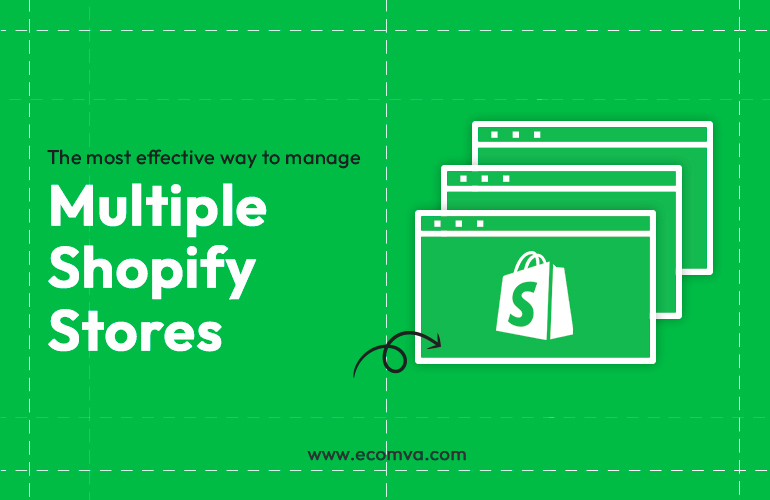The most effective way to manage multiple Shopify stores

“If you think managing one Shopify store is challenging, imagine juggling multiple stores across different markets and niches—but don’t worry, we’ve got the blueprint for success.”
Running multiple Shopify stores isn’t just a sign of growth; it’s a bold move toward scaling your E-commerce empire.
But as Amazon’s Jeff Bezos famously said, “We are stubborn on vision. We are flexible on details.” (Source: Forbes)
This mindset applies perfectly to Shopify multi-store management. While the vision of operating multiple stores is inspiring, the details—like inventory management, Shopify SEO, and ensuring consistent branding—can be daunting.
According to Shopify, merchants who use streamlined management systems see a significant increase in efficiency and growth, with some reporting up to a 30% boost in productivity. However, most store owners face challenges like maintaining optimized operations and balancing their workload effectively. The stakes are high, but so are the rewards if you get it right.
In this blog, we’ll reveal expert-approved strategies to manage multiple Shopify stores, enhance Shopify store optimization, and conquer common E-commerce management challenges. Whether you’re running two stores or twenty, these solutions will empower you to thrive in the competitive E-commerce world. Keep reading to unlock the full potential of your Shopify stores.
What is the Shopify Multi-Store Feature?
Shopify’s multi-store feature allows businesses to create and manage multiple storefronts under one account. This functionality is perfect for businesses selling a variety of products, targeting global markets, or segmenting brands. Here’s why it stands out:
- Unlimited Stores: Shopify lets you create as many stores as you need—a boon for scaling businesses.
- Customizable Setups: Each store can have unique themes, apps, and configurations.
- Localized Appeal: Cater to different audiences with tailored content, products, and languages.
| Criteria | What to Check |
|---|---|
| Experience | Proven track record in the E-commerce industry. |
| Platform Expertise | Knowledge of major platforms like Shopify and Amazon. |
| Turnaround Time | Fast service to meet business deadlines. |
| Customization | Tailored solutions for unique business needs. |
| Data Security | Advanced measures to protect sensitive information. |
Learn how to optimize your Shopify store’s speed for better performance and customer experience in our Guide to Accelerating Shopify Speed for Higher Conversions.
How to Set Up Multiple Shopify Stores?
Step 1: Access the Stores Tab
Log in to Shopify admin, locate the dropdown in the top-right corner, and select the “Stores” tab.
Image Source: GemPages Blog
Step 2: Create Another Store
Click on “Create Another Store,” add a unique name, and connect it with your primary account email.
Image Source: GemPages Blog
Step 3: Email Verification
Verify your email to activate the new store. Once done, you can toggle between stores effortlessly.
Step 4: Customize Your Store
Tailor the store’s theme, apps, and products. Replicate existing products if necessary or introduce fresh listings. Ensure each store reflects its unique brand identity.
Step 5: Add Integrations
Integrate essential tools for inventory, order management, and Shopify SEO. These systems streamline operations and enhance performance.
Common Challenges in Managing Multiple Shopify Stores
Managing multiple stores is rewarding but comes with specific challenges. Here are the main hurdles and how to address them:
1. Integration and Inventory Issues
Synchronizing systems like ERP or POS can be complex. Without real-time inventory updates, stockouts or overselling can occur. Leveraging Shopify store management services can help align these integrations seamlessly.
2. SEO Optimization Hurdles
SEO for multiple stores requires precise strategies. Duplicate content or inconsistent optimization can hurt rankings. Each store must focus on unique keywords tailored to its audience.
3. Bulk Product Management
Handling thousands of products across stores can be overwhelming. Inaccurate data or delays can lead to poor customer experiences. Implement robust multi-store setup tools to streamline updates and prevent errors.
4. Customer Service Strain
Providing consistent service across stores is essential but challenging. A centralized support system ensures all customers receive timely responses, maintaining satisfaction.
| Challenge | Solution |
|---|---|
| Integration Issues | Use Shopify store management services |
| Inventory Problems | Implement real-time inventory tools |
| SEO Overwhelm | Create store-specific SEO strategies |
| Bulk Product Management | Utilize robust PIS tools |
| Customer Service Strain | Centralize support systems |
Benefits of Shopify Multi-Store Management
Managing multiple Shopify stores is not just about scaling; it’s about unlocking new opportunities in the global marketplace. With strategic Shopify store optimization, you can create a seamless experience for customers while strengthening your brand’s position. Below are key benefits explained in detail:
1. Expand Internationally and Cater to Niche Markets
With Shopify multi-store management, businesses can target diverse geographical regions effectively. Each store can be tailored to meet the preferences, purchasing behavior, and cultural nuances of a specific region. For instance:
| Feature | Regional Store Example |
|---|---|
| Local Currency Support | USD for the US, EUR for Europe |
| Payment Gateway Options | PayPal for the US, Klarna for Europe |
This ensures customer convenience and trust, which are critical in E-commerce. By catering to niche markets, businesses can also introduce exclusive products, driving demand within specialized communities.
2. Improve Customer Experience with Multi-Language Support
Language barriers can hinder conversions. A Shopify multi-store setup allows you to offer content in multiple languages, directly appealing to local customers. By implementing Shopify SEO strategies in each language, stores rank higher on search engines within their respective regions.
For example:
- A French-language store can target French-speaking audiences.
- Optimized keywords in different languages ensure better visibility.
This approach improves accessibility and fosters a deeper connection with customers.
3. Enhance Brand Identity and Segmentation
Managing multiple Shopify stores provides businesses the ability to distinguish product lines or brands effectively. You can create unique branding, from design to messaging, for each store, ensuring precise audience targeting.
Here’s how it works:
Parent Brand Example: A clothing company operates two Shopify stores.
Store 1: High-end luxury apparel.
Store 2: Affordable casual wear.
This segmentation allows better communication with distinct customer groups while addressing their specific needs. Shopify store management services can further help optimize operations for seamless segmentation.
By overcoming E-commerce management challenges, businesses using Shopify multi-store management tools can maintain operational efficiency, improve customer satisfaction, and maximize revenue. Ensure every store benefits from Shopify store optimization and robust Shopify SEO practices for consistent growth.
Effective Management Strategies for Multiple Shopify Stores
Managing multiple Shopify stores can be challenging, but with the right strategies, businesses can streamline operations and maximize their impact. Shopify multi-store management is about ensuring efficiency and consistency while catering to each store’s unique needs. Here are some practical strategies to optimize your efforts:
1. Store-specific SEO and Centralized Tools
Each Shopify store should have its own SEO strategy to target specific audiences effectively. Shopify SEO plays a crucial role in enhancing visibility for each store in search engines. Use keywords relevant to the store’s products and region to drive organic traffic
| Centralized Tools for Efficiency | Key Benefits |
|---|---|
| Shopify store management services | Simplifies operations across stores |
| SEO Management Platforms | Optimizes keywords for better ranking |
Centralized tools can help manage product catalogs, customer data, and marketing campaigns, saving time and effort.
2. Real-Time Inventory and Order Management Systems
For those managing multiple Shopify stores, keeping track of inventory and orders across various locations is vital. Implementing real-time inventory systems ensures that stock levels are updated automatically, reducing overselling or understocking risks.
Advantages include:
- Instant updates on stock availability.
- Seamless synchronization across all stores.
This feature also helps with E-commerce management challenges by improving accuracy and customer satisfaction.
3. Product Information System (PIS) for Seamless Updates
A Product Information System or PIS is considered to be essential for maintaining consistency typically across all Shopify stores. It allows centralized management of product descriptions, pricing, as well as images. By using a PIS, updates can be applied to all stores simultaneously, eliminating manual effort.
| Key Features of PIS | Impact on Multi-Store Setup |
|---|---|
| Centralized product updates | Ensures consistent branding |
| Integration with Shopify SEO | Enhances visibility and ranking |
This tool complements Shopify store optimization by ensuring each store remains up-to-date and aligned with business objectives.
By adopting these strategies, businesses can effectively manage multiple Shopify stores while overcoming E-commerce management challenges. Incorporating centralized tools, real-time systems, and SEO-focused approaches ensures seamless operations and growth.
Conclusion: Maximizing Potential Through Effective Multi-Store Management
Thus, Shopify multi-store management is typically considered to be a vital strategy for businesses looking to scale their E-commerce presence. Well-managed multiple stores offer distinct advantages, from improved customer targeting to enhanced Shopify store optimization. By addressing E-commerce management challenges with centralized tools, real-time inventory systems, and tailored SEO practices, businesses can ensure seamless operations across all stores.
The benefits of managing multiple Shopify stores effectively are clear:
- Streamlined Operations: Centralized management facilitates simplifying key tasks, which helps in ensuring consistency typically across all stores.
- Growth Opportunities: Expanding into new markets becomes easier with a well-organized multi-store setup.
- Improved Customer Experience: Tailored store-specific strategies meet diverse customer needs efficiently.
By implementing these strategies, businesses unlock potential for sustained growth, stronger brand identity, and increased profitability.
FAQs
1. Why should I mainly consider managing multiple Shopify Store instead of one?
Managing multiple stores generally lets you cater to diverse regions, audiences, or product categories. A multi-store setup facilitates making sure customized branding as well as marketing strategies for typically distinct customer groups.
2. What tools can simplify Shopify multi-store management?
Centralized tools like Shopify store management services, real-time inventory systems, and Product Information Systems (PIS) help streamline tasks across stores. These tools reduce manual effort and improve operational efficiency
3. How does Shopify SEO impact multi-store management?
Shopify SEO enhances each store’s visibility on search engines. Optimized keywords as well as localized strategies typically aid individual stores rank higher. Ultimately, it helps in driving organic traffic along with boosting conversions.
4. What are typically the major challenges that are encountered while managing multiple Shopify stores?
Common challenges typically entails inventory mismanagement, inconsistent branding, and time-consuming updates. Addressing these with the right tools and strategies minimizes errors and ensures seamless operations.
5. Can I integrate real-time systems for inventory across multiple Shopify stores?
Yes, real-time inventory management systems are crucial for typically managing stock in an efficient manner. They update inventory levels automatically across all stores, which in turn facilitates preventing the instances of overselling and improving customer satisfaction.












